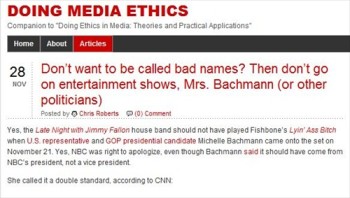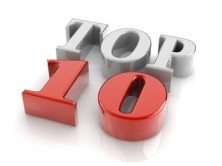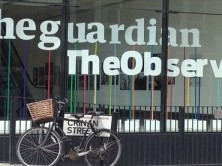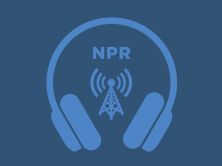
"Doing Ethics in Media" has two companion websites. On DoingEthicsinMedia.com, co-author Chris Roberts weighs in on current events. (Credit: DoingEthicsinMedia.com, screenshot)
Doing Ethics in Media: Theories and Practical Applications by Jay Black and Chris Roberts
“Who wins, who loses? Why not follow the rules?” These ethics questions are among those journalists and others working in media should consider before making ethical decisions, according to a new ethics textbook Doing Ethics in Media: Theories and Practical Applications.
Doing Ethics in Media provocatively suggests that if journalists are trained “in the classroom often and well enough” to analyze media ethics issues, then it won’t be skipped over in the real world. People’s thinking will already “be in place for more rapid and sophisticated decision making under pressure so that each new dilemma is not written upon a blank tablet.”
Of the books StinkyJournalism has reviewed for our “Books, Authors, and Organizations on Media Ethics” series, Doing Ethics in Media is the most introspective. The 13-chapter long textbook, written by Jay Black and Chris Roberts, and published by Routledge, is definitely an academic read.
Black is the Journal of Mass Media Ethics founding co-editor and the Poynter Jamison Chair in Media Ethics, Emeritus at the Univ. of South Florida-St. Petersburg. Roberts is a Univ. of Alabama assistant professor.
Ethics for All Media Professions
The book’s approach to ethics is very inclusive, incorporating all media professions from traditional print journalism to blogging to public relations to the entertainment industry. Co-author Chris Roberts told iMediaEthics by e-mail that “the book is ‘platform agnostic,’ with hopes it is used in both general media ethics classes and in ethics classes for specific professions—journalism, digital media, public relations, advertising or entertainment. Even if students from different professions aren’t in the same class, the reality is that today’s journalist is tomorrow’s PR practitioner, or vice versa, and many in digital media are simultaneously in the news, PR and advertising businesses.”
Doing Ethics in Media traces media ethics’s beginnings to the twentieth century. Developments in media ethics include increased amounts of media criticism, transparency, accountability and media outlets, according to the book.
The book noted that issues in media ethics in countries with developing media outlets varies because journalists can be torn between acting as “truth tellers” and “cheerleaders.” (85)
“Five Ws and H of Media Ethics”
Doing Ethics in Media unifies the different professions by asking the “5Ws and H’ of media ethics.” Instead of the traditional news story Who, What, When, Where, Why, and How questions, Doing Ethics in Media asks readers to analyze from an ethical decision-making approach.
“What’s your problem? Why not follow the rules? Who wins, who loses? What’s it worth? Who’s whispering in your ear? How’s your decision going to look?”
Co-author Roberts told us by e-mail that “What I love about the ‘W’s and H’ approach is its applicability regardless of the task—whether it be mass media, nursing, law, or anything else. I’ve had students tell me they’ve used the ‘W’s and H’ to win a media ethics tournament at a college journalism seminar, and I’ve had students tell me they’ve used it to make decisions about their dating lives. That tells me we’re on to something.”
Roberts told iMediaEthics that Doing Ethics in Media differs from other media ethics textbooks “because the ‘W’s and H’ list provides a new approach to systematically work through ethical dilemmas.” Also, Roberts noted that Doing Ethics in Media includes “some discussion of media entertainment, which I think is underserved in other books.”
The book says its audience is undergraduate and graduate media ethics students. Noting that ethics require “analytical abilities,” The authors write:
“Doing Ethics in Media should be based on moral philosophy and theory, not mere moralizing” (1)
When media practitioners are making ethics decisions, Doing Ethics in Media advises accountability and transparency. Also, the book takes transparency a step further, noting that ethical decisions “should withstand the test of publicity.” According to Doing Ethics in Media, “Transparency is not a simple solution to media credibility problems” (278) Concerning accountability, Black and Roberts noted that they suggest humility foremost. (409)
“Doing Ethics in Media” also has two websites: At DoingMediaEthics.com, Roberts weighs in on current media ethics issues. And book publisher Routledge hosts student resources, like chapter summaries and recommended reading, and instructor resources, like manuals and sample tests.
Q & A with Co-Author Chris Roberts
iMediaEthics: The book is framed around its own version of the 5W’s and H questions. How did you develop this framework & what questions, if any, did you have to leave out?
Roberts: Doing Ethics in Media: Theories and Practical Applications co-author Jay Black is a media ethics pioneer, as a co-founder of the Journal of Mass Media Ethics and a teacher of applied ethics for decades. He developed the “W’s and H” questions—originally called “The Black List”—to give his students a practical, systematic way to think through ethical dilemmas. The questions:
- What’s your problem? (Articulate the question: Is it really an ethical question, or a non-moral issue? Without the right question, you are unlikely to find a defensible answer.)
- Why not follow the rules? (What laws, rules or professional mores apply? What do codes of ethics say? Is it sufficient to follow the “rules,” or does the case demand some autonomous thinking?)
- Who wins, who loses? (Identify the stakeholders and decide who deserves higher loyalties.)
- What’s it worth? (What moral and non-moral values are involved? Prioritize them, and decide which one[s] should not be compromised.)
- Who’s whispering in your ear? (Which school of philosophy or set of moral principles can give you a moral compass? Here’s where you consider what Aristotle, Kant, Mill, and others would say if they shared your office.)
- How’s it going to look? (Issues of transparency and accountability, with the reality that mass communicators, more than others, must pass a test of publicity.)
Routledge asked Jay for years to write a media ethics textbook, and he brought me in for some of the heavy lifting. (I was his graduate assistant when he led the Journalism Department at the University of Alabama in the late 1980s, and we’ve been friends ever since.) Over a long weekend in a cabin at a national forest in Utah, we turned the original idea of a 23-chapter text into 13 chapters, which translates well for an academic semester. We also organized those chapters around the six questions. The result is a 441-page book and two websites.
An otherwise positive reviewer wrote that the toughest part of the book was that there may be too much in it, requiring teachers to decide what to leave out.
iMediaEthics: More so than any of the other books we’ve looked at for our series, this book focuses on moral thought, philosophical thought, etc. Why was/is this important?
Roberts: The first thing the book does—in the Introduction, even before Chapter One—is to differentiate between moralizing and “doing ethics.” Some ethics-focused books in media aren’t really applying ethics; they don’t move past gut reactions or rules proscribed by law or code of ethics. But if you’re following your unthinking gut or only following orders, then you’re not doing ethics.
“Doing ethics” means thinking for yourself. We’ve supplied the tools, and hope readers learn to do their own spading. Those tools are what you mention—moral thought, the wisdom of the ages provided by philosophers, and discussions of issues such as truth, the good and bad of persuasion, diversity, moral development, professionalism, and media traditions. We hope readers can take all of that into account and “front-load” their decisions, so they can make good decisions under the heat of deadlines and competing values and stakeholders. People who can sift through the issues and make ethically justifiable decisions that withstand the light of publicity are the ones we want running the world, or at least the world’s newsrooms and media boardrooms.
iMediaEthics: Similarly, from my read, the book is more a reflective, introspective read than a how-to book. Why did you decide to go this route?
Roberts: While the “W’s and H” list is sort of a “how-to” aid, we know that doing ethics can’t be condensed to a how-to list. Some “how-to” books remind me of the Monty Python How to Do It skit, where learning how to play the flute is explained in a sentence: “You blow there and you move your fingers up and down here.”
The real world isn’t so simple. As we say on the first page of Chapter One, many ethical dilemmas come in “a rainbow of gray.” Most of my students are college seniors, and even at that level of sophistication they become frustrated when I don’t give them “the answer,” as if a moral dilemma were a math problem.
The fun is watching students develop over the semester—we even show them how they develop, with a chapter on moral development theories that is unique to media ethics textbooks. By the end of the semester, many of them have moved into a place where they have discovered (or better clarified) their own ethical voice and are ready to take on the world.
Yes, there’s lots of reflection and introspection, which translates into the word “theories” in the book’s title. But the title’s other key words—“doing” and “practical”—are reminders that mass media practitioners are in a contact sport, where they have to make real decisions that have real consequences. That’s why we quote Kurt Lewin in the Introduction: “There’s nothing quite so practical as a good theory.”
iMediaEthics: In Chapter Three, you introduce the history of media and media ethics, and note that some media members in developing nations could be torn between acting as “cheerleaders” or “truthtellers.” How would you advise journalists in these developing nations to get their feet off the ground and start “doing ethics” if there is no history of what is or isn’t acceptable in that media environment?
We included that chapter because professionals need to understand their profession’s mores and history, and those things are part of the intertwined relationships between governments and media. One of the many media traditions we include, “Developmental Media,” describes media systems in governments moving from revolution to modernization. We’d say that modernization would be described as societies that treasure press freedom, or at least tolerate it without threats of gunshots and prison cells for journalists who dare take up a position counter to the leadership.
As we say on page 86, “the challenges are legion.” The beauty of having no history is that journalists can help write that history and guide through what’s not yet charted. I’d say more, but then it turns into the aforementioned How to Do It skit.
iMediaEthics: Some of the most-discussed media ethics stories in the past year have been related to the UK phone hacking scandal or WikiLeaks : large-scale issues. On the smaller, day-to-day scale, what ethical issues or decisions do you think pose the most problems for the average journalist in his or her work?
Roberts: The two cases stories you mention seem like no-brainers. The UK wiretapping scandal reminds me of what we said on page 219 in dismissing talk of the likes of Jayson Blair and other famous media liars: “media ethicists don’t find them philosophically interesting.” The phone hacking question could be posed this way: “Is it OK for me to wiretap to overhear the secrets of supermodel Elle Macpherson?” That’s an ethical no-brainer; not only is it illegal, but only moral troglodytes would do that.
The WikiLeaks question seems tough, too, but not to The New York Times and the other media outlets that did real journalism based on the findings. The Times and others, had they used the “W’s and H” list, might have posed the “What’s your problem?” question this way: “Is it OK to publish potentially stolen material that shows governments say one thing to themselves and something completely different to the public?” Their list of stakeholders put readers first, and their values put truthtelling of national importance over potential harm, which they further mitigated by redacting potentially harmful information and giving the administration the opportunity to suggest more redactions before publication. And The Times answered the last question, “How’s it going to look?” by explaining its reasoning. The bottom line is that The Times “did ethics” even as it “did journalism,” the opposite of the late News of the World.
As for average journalists, the Society of Professional Journalists’ code of ethics does a good job of defining the categories of issues a journalist will face: truthtelling, minimizing harm, independence and accountability. (But the code, like nearly every code, can’t provide solutions to the hard questions.)
Good journalists occasionally find themselves deciding about revealing sources, identifying minors and crime victims, and balancing real or imagined conflicts of interest. I think the drastic cuts in the number of journalists and the cuts in newshole are leading to exacerbation of other issues: trying to move beyond the easy and quick when there’s no time and little space, trying to focus on the task when worrying about losing your job or having survivor’s guilt, and pushing past the image-making machinery of governments, businesses and other organizations to tell a fuller truth.

See above the cover of Doing Ethics in Media.
CASE STUDIES
Each chapter features case studies. Case studies present a gamut of issues from conflict of interest to transparency to sedition and are framed in any profession from a newspaper to the movies.
The case studies build throughout the chapter, either posing more complex scenarios or asking readers to analyze their original answer from a different perspective. For example, by Chapter 4, readers are asked to review their responses to the first chapter’s case study, but instead “don’t concentrate on what you should decide,” and “focus on how you argued.” (108)
Case studies are for the large part fictional events or real events made fictitious by changing some of the details.
ETHICS CODES
“Doing Ethics in Media” differentiated between aspirational and minimal codes (minimal being a checklist of what you can and can’t do). According to the book, “The strength of an ethics code lies not only in its words, but in its legitimacy and power in the eyes of those for whom it is written. People will obey because they willingly subject themselves to ethical standards above and beyond their own personal belief, or because the code has specific provisions for enforcement they feel will be invoked should they violate it.” (46)
Further, Doing Ethics in Media commented on the need for accountability within ethics codes, even though most codes are “generally unenforceable.” (404) The authors write:
“Accountability implies moral sanction, and we cannot maintain a community with explicit functions without attaching specific rebukes for failing to meet obligations. Follow practitioners/peers need to be the ones calling each other to account.” (47)
In many decisions, Doing Ethics in Media included a variety of tests and discussion models, including the Society of Professional Journalists’ four main tenets (Seek Truth and Report it, Minimize Harm, Act Independently, and Be Accountable).
Also included is Dr. Ralph Potter’s Potter Box, which calls for people to “define the ethical situation or dilemma objectively and in detail,” “identify values that relate,” incorporate any moral justifications, and then determine loyalties. “The goal is not to force a choice, but to help the individual understand and ethically justify a decision,” Doing Ethics in Media’s authors noted. (53)
PRIVACY
Doing Ethics in Media also addressed privacy issues, which the authors called “some of the most vexing issues in today’s media ethics environment. ” (238) The authors questioned what privacy really is and how it factors into media ethics.
In general, Doing Ethics in Media advises that the media follows a “delicate balance” in not harming people. “The issues are complex, and no simple rules will resolve them,” according to the book, which notes ethics standards related to privacy tend to grant a form of protection to “the innocent, or naive, or disenfranchised members of society.” ( 248)
Chapter Seven focuses on “Truth and Deception,” noting that “truth telling” is “one of the most important values in the media ethics environment.” (199) Areas in which truth comes into play includes photo fakery with the high profile case of TV Guide’s1989 photoshop of Oprah on Ann-Margret’s body, fake memoirs like James Frey’s A Million Little Pieces, fake information from governments, and undercover reporting. Doing Ethics in Media marks 1994 as the turning point with the two high-profile photoshops of Newsday’s “composite photo” of ice skaters Nancy Kerrigan and Tanya Harding and Time’s O.J. Simpson photo. (200)
Issues for media professionals, according to Black and Roberts include: “how to seek the truth, how to tell the truth, when to balance truth telling against their compelling values, when to be a selective truth teller, and when it may be ethically justifiable to deceive for a great good.” (199)
Deception can be exhibited through manipulative sources, certain marketing campaigns, and so forth, according to Doing Ethics in Media. (220)
Diversity, Values, & Loyalty
Black and Roberts explained that they “prefer” loyalty as “to people and secondarily to institutions.” They also suggested differentiating “personal loyalty from notions of principles and values,” and “between sentimental and unsentimental loyalty.” (141, 144) Further, Black and Roberts noted that they “are driven more by social responsibility than by individualism, and more by openness to change than by organizational and personal security.” (196)
Doing Ethics in Media added that ultimately “news is not value-free” and journalists should be transparent about this.
Doing Ethics in Media highlighted Poynter’s five guidelines regarding “racial identifiers” in news stories including “is it relevant” and “have I explained the relevance?” (149). The book also features a series of helpful questions regarding the inclusion of race or racial elements in stories.
Also, Black and Roberts included an essay on diversity by St. Petersburg Times’ Eric Deggans. Deggans highlighted the way that the entertainment media portrays race and how that reflects in society and also responded to criticism of “diversity as a scam” by writing:
“Seeing diversity initiatives mostly as a means for social justice or as window-dressing misses the point. Diversity in media — especially for newsrooms and news content — is important because it enables two other vitally important ethical values: accuracy and fairness” (155)
Women & Ethics
Doing Ethics in Media also devotes a section in its chapter on “Moral Development and the Expansion of Empathy” to the way women perceive ethics. For example, according to Doing Ethics in Media, Lawrence Kohlberg, a psychologist in the mid-20th century, presented moral development in an evolutionary light: As people mature, their morals mature.
However, psychologist and ethicist Carol Gilligan criticized Kohlberg for failing to incorporate “dimensions of moral development that are especially characteristic of females,” like mother-daughter bond. For example, “Compassion, not justice, is a dominant ethic of women.”(118)
According to Doing Ethics in Media, “Gilligan does not insist that morality is gender-based.” (120)
Doing Ethics in Media also cited the thoughts of Mary Belensky, who focused specifically on “women’s ways of knowing.”
“We suggest that message creators engage in propaganda when they repeatedly jump to dogmatic conclusions, rely unduly on authority, base assumptions on faulty premises, and otherwise engage in inappropriate semantic behavior.” (286)
Disclosures: We received a review copy of this book from the publisher, Routledge. Also, Chris Roberts is a former professor: He, with two other professors, led the senior semester “Carolina Reporter” program which I took in the spring of 2008.






